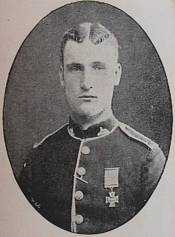John Williams (VC)
| John Williams VC | |
|---|---|
 | |
| Birth name | John Fielding |
| Born |
24 May 1857 Abergavenny, Wales |
| Died |
25 November 1932 (aged 75) Llantarnam, Cwmbran, Wales |
| Buried at | St Michael's Churchyard, Llantarnam |
| Allegiance |
|
| Service/branch |
|
| Rank | Sergeant |
| Unit |
|
| Battles/wars |
|
| Awards | Victoria Cross |
John Williams VC (born John Fielding 24 May 1857 – 25 November 1932), was a Welsh recipient of the Victoria Cross, the highest and most prestigious award for gallantry in the face of the enemy that can be awarded to British and Commonwealth forces.
Details
John Fielding was the second eldest of ten children. John's parents were Michael and Margaret Godsil, who married in Abergavenny, Wales in 1855. Both Michael and Margaret were from Cork, Ireland. Michael Fielding died at the age of 82 and is buried in the Cwmbran cemetery. John was born at Merthyr Road, Abergavenny. The entire family were Catholic. John was 5 feet 8 inches (1.72m) tall. Born Fielding, he enlisted under the name of Williams in the Monmouthshire Militia in 1877.
He was 21 years old, and a private in the 2nd Battalion, 24th Regiment of Foot (later The South Wales Borderers), British Army during the Anglo-Zulu War when the following deed took place for which he was awarded the VC. It is known neither why he chose to join the army, nor why he enlisted in a name other than his own. (It may possibly have been to avoid being traced after running away from home).[1]
On 22–23 January 1879 at Rorke's Drift, Natal, South Africa, Private Williams and two other men held a distant room of the hospital for more than an hour until they had no ammunition left, when the Zulus burst in and killed one of the men and two patients. Meanwhile Private Williams had succeeded in knocking a hole in the partition and took the two remaining patients through into the next ward. He was there joined by Alfred Henry Hook, and working together (one holding the enemy at bayonet point while the other broke through three more partitions) they were able to bring eight patients into the inner line of defence. His citation read:
Private John Williams was posted with Private Joseph Williams, and Private William Horrigan, 1st Battalion 24th Regiment, in a distant room of the hospital, which they held for more than an hour, so long as they had a round of ammunition left: as communication was for the time cut off, the Zulus were enabled to advance and burst open the door ; they dragged out Private Joseph Williams and two of the patients, and assagaied them. Whilst the Zulus were occupied with the slaughter of these men a lull took place, during which Private John Williams, who, with two patients, were the only men now left alive in this ward, succeeded in knocking a hole in the partition, and in taking the two patients into the next ward, where he found Private Hook.These two men together, one man working whilst the other fought and held the enemy at bay with his bayonet, broke through three more partitions, and were thus enabled to bring eight patients through a small window into the inner line of defence.[2]
He was presented with his VC in Gibraltar by Major-General Anderson, Governor of Gibraltar in 1880.
Further information
Fielding later achieved the rank of Sergeant in the 3rd Volunteer Battalion, South Wales Borderers. In 1914, he volunteered for service and served on the SWB Depot staff at Brecon throughout World War I and served as a recruiting agent for them. He married Elizabeth Murphy and they had 3 sons and 3 daughters; one son was killed while serving with 1/SWB during the Retreat from Mons in 1914.
He died from heart failure in Cwmbran on 24 November 1932. The nursing home directly opposite his burial place in Llantarnam, Cwmbran was later named in his honour, as was a local J.D. Wetherspoon's pub, the John Fielding, wherein hangs his picture.

The medal
His Victoria Cross was donated to the SWB Museum by the Fielding family and is displayed at the South Wales Borderers Museum in Brecon, Powys, Wales.
Notes
- ↑ Lloyd 1993.
- ↑ The London Gazette: no. 24717. p. 3177. 2 May 1879. Retrieved 24 December 2009.
References
- Monuments to Courage Harvey, David. (1999).
- John Williams VC: A Biography Lloyd, W.G. (1993)
- The Register of the Victoria Cross This England. (1997)
External links
- John Williams (Fielding) (biography, photos, memorial details)
- Location of grave and VC medal
- The location of his grave is at coordinates 51°37′58.61″N 3°0′11.94″W / 51.6329472°N 3.0033167°W